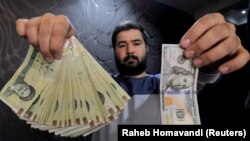The Iranian currency has taken another dive against major world currencies, by breaking through the 42,000 rials to the U.S. dollar threshold.
The Iranian rial passed the 40,000 threshold in October and slowly continued its downward trend. In mid-November, it was trading at 41,000 to the dollar.
But on Wednesday, in Tehran’s retail exchanges, the rial reached a new low of 42,260 against the dollar.
The exact reasons for this steady decline are not clear. In general terms, uncertainty related to Iran’s relations with the U.S., its western allies and Arab countries plus its multiple economic vows can be blamed.
Although the 2015 nuclear deal lifted all nuclear related sanctions, but others remain in place. In addition, U.S. posturing against the Islamic Republic has kept many investors away from the Iranian market.
This year, the U.S. targeted more Iranian individuals and companies with unilateral sanctions, accusing them of helping Iran’s ballistic missile program and other illicit activities.
Iran’s banks are also facing serious problems with attracting new deposits. During the past 12 months, the shares of major banks have lost around 20% of their value on Tehran’s stock exchange.
All major currencies have risen against the rial, notably the British pound. Gold and gold coins are also trading higher.
Some Iranian economists say that the drop in rial’s value is engineered by the government to fill its coffers. Since the government is the only large supplier of foreign currencies locally, the higher it can sell these currencies to dealers and the people, the more rials it can get to finance its budget.
President Hassan Rouhani disputed this claim in a report he released on the first hundred days of his second term, on November 28.
“The idea that we increase the price of foreign currencies to boost government revenues is not true. All government efforts are aimed at keeping a balance in the value of currencies”, he insisted. He also assured the public that the government’s finances are in order and people should not worry about any significant decline in the value of their national currency.
But rial’s decline has continued since Rouhani felt obliged to address the issue.


